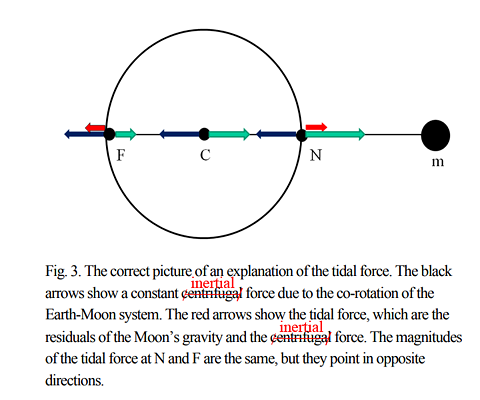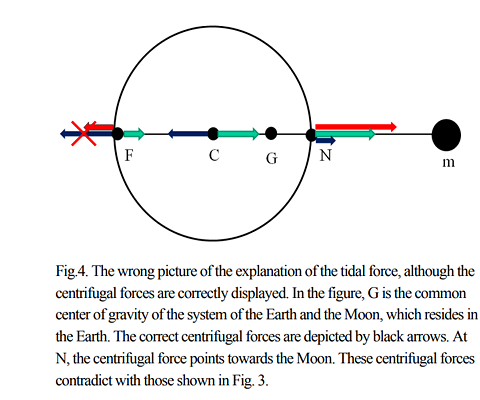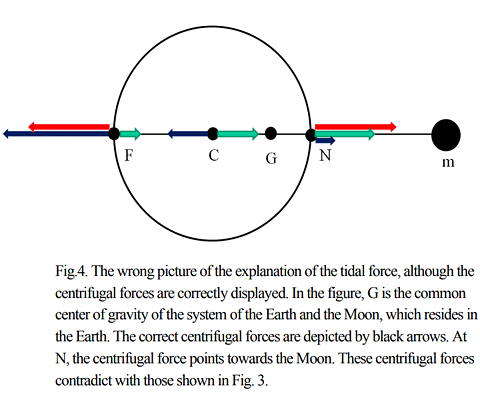Amendment to Matsuda, et al.: "Confusion around the tidal force and the centrifugal force" (2015)
Tsuneoka (1993, in Japanese) was probably the first in Japan to point out that it is wrong to explain tidal forces in terms of "centrifugal forces."
Unfortunately, it was published in a minor physics education journal, so its impact seems to have been limited.
Matsuda, an astrophysicist, also pointed out the problem of using "centrifugal force," in his books and papers.
However, there are a few points that Matsuda seems to have misunderstood, which I would like to correct here.
Matsuda et al. (2015) begin their discussion by pointing out that the illustration used in textbooks
(Fig. 3 in their original paper) is correct.
The textbook diagram is indeed correct, but as I explained in the main text of this article,
most textbooks incorrectly refer to translational inertial force as centrifugal force.
If Matsuda et al. refer to "constant centrifugal force" for translational inertia force as in the textbooks,
they would be following the misuse of centrifugal force.
It should be written as "uniform inertial force" or "translational inertial force."
As long as the term "centrifugal force" is used, it will be difficult to clear up the confusion.
 |
| Fig. 3 in Matsuda, et al. (2015).
This force is not "centrifugal force." It should be correctly written as "inertial force." |
Matsuda et al. also point out in the figure (Fig. 4 in the original paper) that
using the real centrifugal force appearing in the rotating system does not produce the correct tidal force. Unfortunately, however, the resultant force is too small because the arrow of the centrifugal force on the side far from the moon is drawn too short.
If drawn properly, the magnitude of the resulant force should be the same as that on the side close to the moon as far as the approximation holds, as shown in Fig. 4b.
 |
| Fig. 4 in Matsuda, et al. (2015).
Unfortunately, in the original figure,
the centrifugal force on the side far from the moon is drawn too small. |
 |
| Fig. 4b, a revised version by the author.
The centrifugal force on the side far from the moon is redrawn correctly. |
- Tsuneoka, Y.: "On the usage of centrifugal force" , Physics Education, 41, 38 (1993), in Japanese.
- Matsuda, T., and Isaka, H.: Tidal forces and tides, Annual Meeting of Japan Society of Fluid Mechanics (2009), in Japanese.
- Matsuda, T.: Common misconceptions about tidal and centrifugal forces, JEin Institute for Fundamental Science (2013), in Japanese.
- Matsuda, T.: Physics full of mistakes, Gakken Publ. (2014), in Japanese.
- Matsuda,T., Isaka, H., and Boffin, H.M.J.: Confusion around the tidal force and the centrifugal force, Bulletin of JEin Institute for Fundamental Science (2015).
Back
Takao FUJIWARA, 2022/12



